-
 Bitcoin
Bitcoin $106,754.6083
1.33% -
 Ethereum
Ethereum $2,625.8249
3.80% -
 Tether USDt
Tether USDt $1.0001
-0.03% -
 XRP
XRP $2.1891
1.67% -
 BNB
BNB $654.5220
0.66% -
 Solana
Solana $156.9428
7.28% -
 USDC
USDC $0.9998
0.00% -
 Dogecoin
Dogecoin $0.1780
1.14% -
 TRON
TRON $0.2706
-0.16% -
 Cardano
Cardano $0.6470
2.77% -
 Hyperliquid
Hyperliquid $44.6467
10.24% -
 Sui
Sui $3.1128
3.86% -
 Bitcoin Cash
Bitcoin Cash $455.7646
3.00% -
 Chainlink
Chainlink $13.6858
4.08% -
 UNUS SED LEO
UNUS SED LEO $9.2682
0.21% -
 Avalanche
Avalanche $19.7433
3.79% -
 Stellar
Stellar $0.2616
1.64% -
 Toncoin
Toncoin $3.0222
2.19% -
 Shiba Inu
Shiba Inu $0.0...01220
1.49% -
 Hedera
Hedera $0.1580
2.75% -
 Litecoin
Litecoin $87.4964
2.29% -
 Polkadot
Polkadot $3.8958
3.05% -
 Ethena USDe
Ethena USDe $1.0000
-0.04% -
 Monero
Monero $317.2263
0.26% -
 Bitget Token
Bitget Token $4.5985
1.68% -
 Dai
Dai $0.9999
0.00% -
 Pepe
Pepe $0.0...01140
2.44% -
 Uniswap
Uniswap $7.6065
5.29% -
 Pi
Pi $0.6042
-2.00% -
 Aave
Aave $289.6343
6.02%
Is the sideways movement of MFI above 80 the main force controlling the market? When will it adjust?
A sideways MFI above 80 signals strong buying pressure despite stalled price movement, hinting at potential market adjustments once equilibrium breaks.
Jun 16, 2025 at 05:21 am
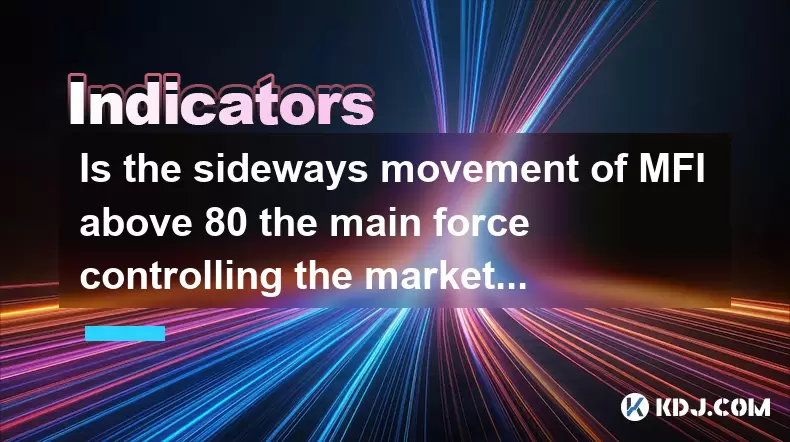
Understanding the MFI Indicator and Its Role in Market Analysis
The Money Flow Index (MFI) is a technical oscillator used to measure buying and pressure in a given market. It combines price and volume data to determine overbought or oversold conditions. Typically, an MFI reading above 80 indicates overbought territory, while below 20 signals oversold conditions. However, when the MFI remains in a sideways pattern above 80 for an extended period, it raises questions about whether this stagnation is influencing broader market movements.
A sideways movement of MFI above 80 suggests that despite high money inflow, prices are not surging significantly. This could imply a consolidation phase where buyers and sellers are in equilibrium, even though momentum appears strong from a volume perspective.
What Does Sideways MFI Above 80 Indicate?
When the MFI moves sideways while remaining above 80, it reflects a scenario where there's consistent accumulation but no significant breakout. This can happen during periods of market indecision, where traders are buying aggressively, yet price action doesn't reflect a clear upward trajectory.
- Volume may be increasing, but prices remain flat due to profit-taking or resistance levels.
- Traders might be accumulating at key support zones, which prevents sharp drops but also restricts upside movement.
- Market sentiment could be mixed, with bulls and bears canceling each other out temporarily.
This behavior often occurs before major breakouts or breakdowns, making it crucial to monitor volume spikes or sudden shifts in the MFI trend.
Is the Sideways MFI Controlling the Entire Market Movement?
While the MFI provides valuable insights into capital flow, it should not be viewed as the sole determinant of market direction. Multiple indicators and external factors influence cryptocurrency markets simultaneously. These include macroeconomic news, exchange inflows/outflows, whale activity, and regulatory developments.
- The MFI alone cannot predict price reversals or continuations; it must be used in conjunction with tools like RSI, MACD, and moving averages.
- Institutional trading patterns often override retail-driven momentum indicators like MFI.
- Market depth and order book analysis offer additional context that MFI does not capture.
Therefore, although a stagnant MFI above 80 might suggest underlying strength, it does not independently control the broader market dynamics.
Identifying Potential Adjustment Points in the Market
An adjustment typically occurs when the balance between buying and selling pressure changes. Sideways MFI above 80 often precedes a directional move once the equilibrium breaks. The following signs may indicate an imminent adjustment:
- A drop in MFI below its recent consolidation range could signal weakening buying pressure.
- Price breaking key support or resistance levels accompanied by a divergence in MFI confirms a shift.
- Sudden increase in volatility, especially after prolonged low-range movement, often triggers adjustments.
Monitoring these elements helps traders anticipate possible corrections or rallies without relying solely on MFI readings.
How to Trade During MFI Consolidation Phases
Trading during sideways MFI phases requires patience and a structured approach. Here’s how you can navigate such conditions effectively:
- Use multiple time frame analysis: Check higher time frames (like 4-hour or daily charts) to understand the broader trend.
- Watch for divergences: If price makes new highs but MFI fails to confirm, it could indicate weakness ahead.
- Place stop-loss orders strategically: Set them beyond key support/resistance to avoid false breakouts.
- Wait for confirmation candles: Avoid entering trades prematurely; wait for strong candlestick patterns post-consolidation.
- Combine with volume profiles: High volume during a breakout increases the probability of continuation.
By integrating these strategies, traders can better position themselves during uncertain market phases driven by sideways MFI behavior.
Frequently Asked Questions
Q: Can MFI stay above 80 indefinitely?
Yes, the MFI can remain above 80 for extended periods, especially during strong uptrends or accumulation phases. However, sustained readings above 80 without corresponding price movement often lead to eventual corrections.
Q: What other indicators complement MFI well during consolidation?
Indicators like the Relative Strength Index (RSI), On-Balance Volume (OBV), and Bollinger Bands provide useful context alongside MFI. Combining them enhances accuracy in identifying potential breakouts or breakdowns.
Q: How reliable is MFI divergence in predicting market adjustments?
MFI divergence can be a powerful signal, but it's not foolproof. False divergences occur frequently in volatile crypto markets. Always verify with price action and volume before making decisions.
Q: Should I ignore MFI if the market is sideways?
No, you shouldn’t ignore MFI entirely. Instead, use it to gauge internal strength or weakness. A sideways MFI above 80 may indicate hidden bullish energy waiting to erupt upon a catalyst.
Disclaimer:info@kdj.com
The information provided is not trading advice. kdj.com does not assume any responsibility for any investments made based on the information provided in this article. Cryptocurrencies are highly volatile and it is highly recommended that you invest with caution after thorough research!
If you believe that the content used on this website infringes your copyright, please contact us immediately (info@kdj.com) and we will delete it promptly.
- 2025-W Uncirculated American Gold Eagle and Dr. Vera Rubin Quarter Mark New Products
- 2025-06-13 06:25:13
- Ruvi AI (RVU) Leverages Blockchain and Artificial Intelligence to Disrupt Marketing, Entertainment, and Finance
- 2025-06-13 07:05:12
- H100 Group AB Raises 101 Million SEK (Approximately $10.6 Million) to Bolster Bitcoin Reserves
- 2025-06-13 06:25:13
- Galaxy Digital CEO Mike Novogratz Says Bitcoin Will Replace Gold and Go to $1,000,000
- 2025-06-13 06:45:13
- Trust Wallet Token (TWT) Price Drops 5.7% as RWA Integration Plans Ignite Excitement
- 2025-06-13 06:45:13
- Ethereum (ETH) Is in the Second Phase of a Three-Stage Market Cycle
- 2025-06-13 07:25:13
Related knowledge
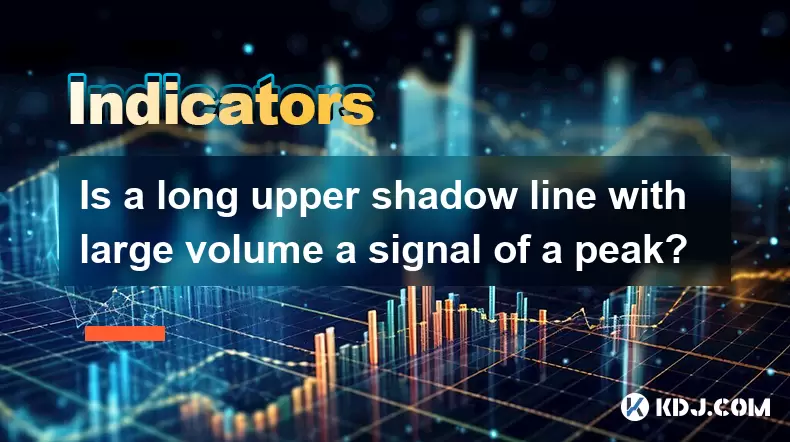
Is a long upper shadow line with large volume a signal of a peak?
Jun 17,2025 at 05:07am
Understanding the Long Upper Shadow LineA long upper shadow line, often referred to as a shooting star or inverted hammer depending on its location in a chart, is a candlestick pattern that indicates potential reversal from an uptrend. This pattern forms when prices rise significantly during the trading period but then fall back to close near the openin...

How to confirm the effectiveness of the average price line support in the time-sharing chart?
Jun 17,2025 at 12:56am
Understanding the Time-Sharing Chart and Its RelevanceIn cryptocurrency trading, time-sharing charts play a crucial role in analyzing short-term price movements. These charts typically display price fluctuations over a specific period, often ranging from minutes to hours. Traders rely on them to make quick decisions based on real-time data. The average ...

What does it mean when the momentum indicator breaks above the zero axis?
Jun 17,2025 at 12:43am
Understanding the Momentum IndicatorThe momentum indicator is a technical analysis tool used to measure the speed or velocity of price movements in cryptocurrency markets. It helps traders identify potential trend reversals, overbought or oversold conditions, and confirms existing trends. The indicator typically oscillates around a zero line, with value...
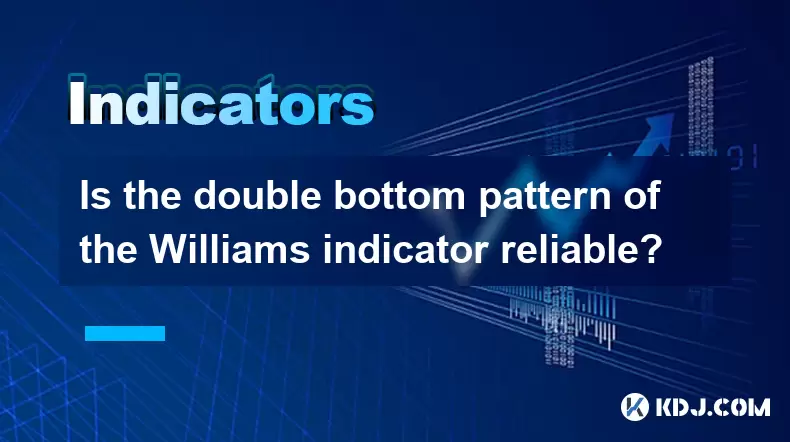
Is the double bottom pattern of the Williams indicator reliable?
Jun 17,2025 at 03:56am
Understanding the Williams Indicator and Its SignificanceThe Williams %R indicator, often referred to as Williams Percent Range, is a momentum oscillator used in technical analysis to identify overbought or oversold conditions in the market. Developed by Larry Williams, this indicator fluctuates between 0 and -100, with readings above -20 indicating ove...
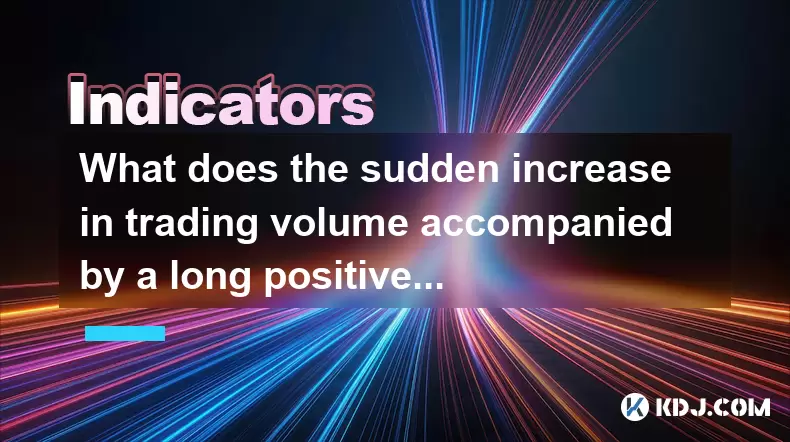
What does the sudden increase in trading volume accompanied by a long positive line mean?
Jun 17,2025 at 06:01am
Understanding the Sudden Surge in Trading VolumeWhen traders observe a sudden increase in trading volume, it typically signals a significant shift in market sentiment. This surge often indicates that more participants are entering or exiting positions, which could be due to news events, macroeconomic data releases, or institutional activity. High tradin...
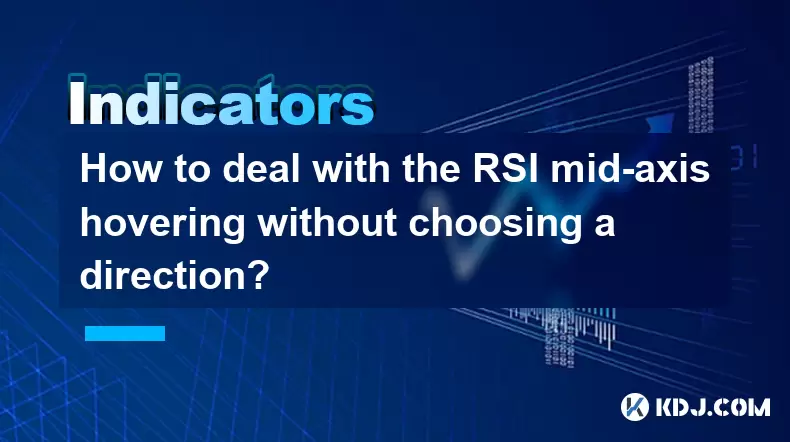
How to deal with the RSI mid-axis hovering without choosing a direction?
Jun 17,2025 at 02:02am
Understanding RSI Mid-Axis Hovering in Cryptocurrency TradingThe Relative Strength Index (RSI) is a popular momentum oscillator used by traders to assess whether an asset is overbought or oversold. In cryptocurrency markets, it's common for the RSI to hover around its mid-axis, typically at the 50 level, without showing a clear upward or downward trend....

Is a long upper shadow line with large volume a signal of a peak?
Jun 17,2025 at 05:07am
Understanding the Long Upper Shadow LineA long upper shadow line, often referred to as a shooting star or inverted hammer depending on its location in a chart, is a candlestick pattern that indicates potential reversal from an uptrend. This pattern forms when prices rise significantly during the trading period but then fall back to close near the openin...

How to confirm the effectiveness of the average price line support in the time-sharing chart?
Jun 17,2025 at 12:56am
Understanding the Time-Sharing Chart and Its RelevanceIn cryptocurrency trading, time-sharing charts play a crucial role in analyzing short-term price movements. These charts typically display price fluctuations over a specific period, often ranging from minutes to hours. Traders rely on them to make quick decisions based on real-time data. The average ...

What does it mean when the momentum indicator breaks above the zero axis?
Jun 17,2025 at 12:43am
Understanding the Momentum IndicatorThe momentum indicator is a technical analysis tool used to measure the speed or velocity of price movements in cryptocurrency markets. It helps traders identify potential trend reversals, overbought or oversold conditions, and confirms existing trends. The indicator typically oscillates around a zero line, with value...

Is the double bottom pattern of the Williams indicator reliable?
Jun 17,2025 at 03:56am
Understanding the Williams Indicator and Its SignificanceThe Williams %R indicator, often referred to as Williams Percent Range, is a momentum oscillator used in technical analysis to identify overbought or oversold conditions in the market. Developed by Larry Williams, this indicator fluctuates between 0 and -100, with readings above -20 indicating ove...

What does the sudden increase in trading volume accompanied by a long positive line mean?
Jun 17,2025 at 06:01am
Understanding the Sudden Surge in Trading VolumeWhen traders observe a sudden increase in trading volume, it typically signals a significant shift in market sentiment. This surge often indicates that more participants are entering or exiting positions, which could be due to news events, macroeconomic data releases, or institutional activity. High tradin...

How to deal with the RSI mid-axis hovering without choosing a direction?
Jun 17,2025 at 02:02am
Understanding RSI Mid-Axis Hovering in Cryptocurrency TradingThe Relative Strength Index (RSI) is a popular momentum oscillator used by traders to assess whether an asset is overbought or oversold. In cryptocurrency markets, it's common for the RSI to hover around its mid-axis, typically at the 50 level, without showing a clear upward or downward trend....
See all articles

























































































